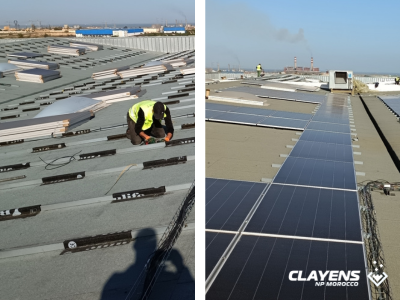A sustainable energy strategy: concrete actions at Clayens

Implementing green energy actions has become a priority for many companies and governments as part of the ecological transition. Decarbonizing the energy system is crucial to meeting the climate goals outlined in the Paris Agreement.
At Clayens, we have chosen to take concrete action to reduce our energy impact. Clayens is committed to lowering its carbon footprint in line with the 1.5°C trajectory validated by the SBTi. Thanks to the dedication of our teams, we have already reduced our emissions by 27% since 2019. This achievement is the result of various initiatives across our sites and a reduction in our energy consumption.
A sustainable energy transition led by Clayens teams
From commitment to action: Clayens focuses on green energy contracts
Sustainable energy: a pillar of Clayens’ energy strategy
Green energy is clean, renewable energy that comes from sustainable sources and emits little to no greenhouse gases.
Some of Clayens' sites are located in countries with highly carbon-intensive energy mixes, so carbon-reduction solutions were considered. Clayens chose to start its reduction trajectory by signing green electricity contracts for its two Polish sites.
Energy transition: green electricity contracts for our polish plants
In 2023, around 88% of Polish electricity is produced using fossil fuels. In comparison, this results in 19 times more CO2 emissions than France.
The Polish site NP Piascezno was the first in the Group to sign a green electricity contract in 2021. To optimize efforts, the contract was renewed in 2022 to include Clayens NP Polska, creating a cohesive energy management approach for both Polish sites.
At the same time, Clayens continues its energy transition journey.
Certified ISO 14001 since November 2021, Clayens NP Polska follows an environmental approach aligned with Clayens' strategy, allowing for a continuous reduction in energy consumption.
Energy transition: Clayens NP Germany adopts green energy for lowering its carbon footprint
With Germany’s energy mix deteriorating over recent years, transitioning to a green energy contract has become highly beneficial for the Group's carbon footprint. Clayens NP Germany signed its contract in September 2023.
The switch to more sustainable energy allows the site to achieve a 5% reduction in the carbon footprint of the EMEA* Group.
Before securing a green energy contract, Clayens NP Germany had already been reducing energy consumption through best practices in place under the ISO 50001 standard for over 6 years.
Solar power plant at Clayens: an innovative solution for a sustainable energy transition
Solar power plant in Morocco: a step towards sustainability
In March 2022, Clayens NP Morocco installed a photovoltaic solar power plant covering its entire roof. Comprising 560 photovoltaic panels, the plant allows the site to avoid rising energy prices and stabilize the cost of its energy mix while preserving the environment.
The solar plant covers about 9% of the site’s energy consumption and has helped reduce Clayens NP Morocco’s carbon footprint by 9%. The plant also positively impacts the Group’s energy transition, contributing to a 1.4% reduction in the overall Group carbon footprint.
Looking ahead: Clayens continues its sustainable energy transition
In line with the roadmap approved by SBTi, solar power plant projects are being studied for the Clayens NP Hungaria and Clayens NP Tunisia sites, set for 2025-2026.
Additionally, as part of its energy consumption reduction goals, Clayens intends to continue implementing and applying best energy practices across its sites. These practices will begin to roll out at NAM* in 2024, with deeper integration in 2025.
Along with this, the ISO 14001 certification will be expanded to several Group sites, including newly acquired NAM* sites.
For more information, you can view our 2023 CSR report and on our website under the "Our CSR Commitments" section.
*EMEA refers to the States of Europe, the Middle East and Africa.
*NAM refers to North America.
